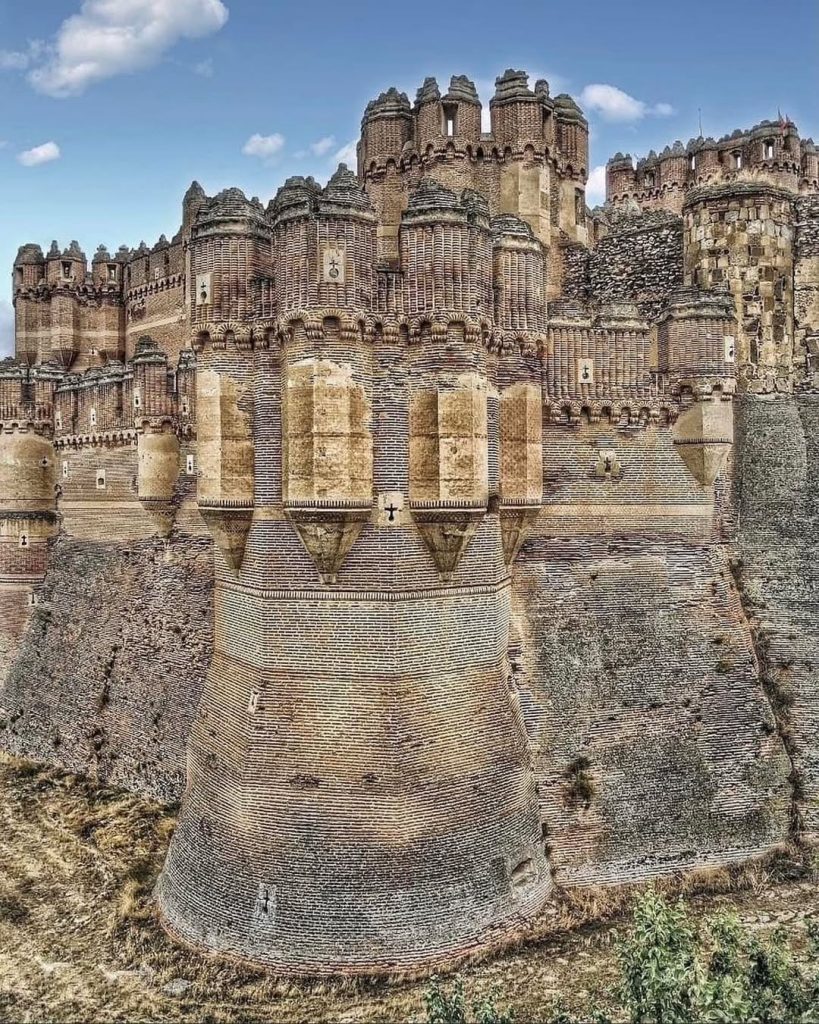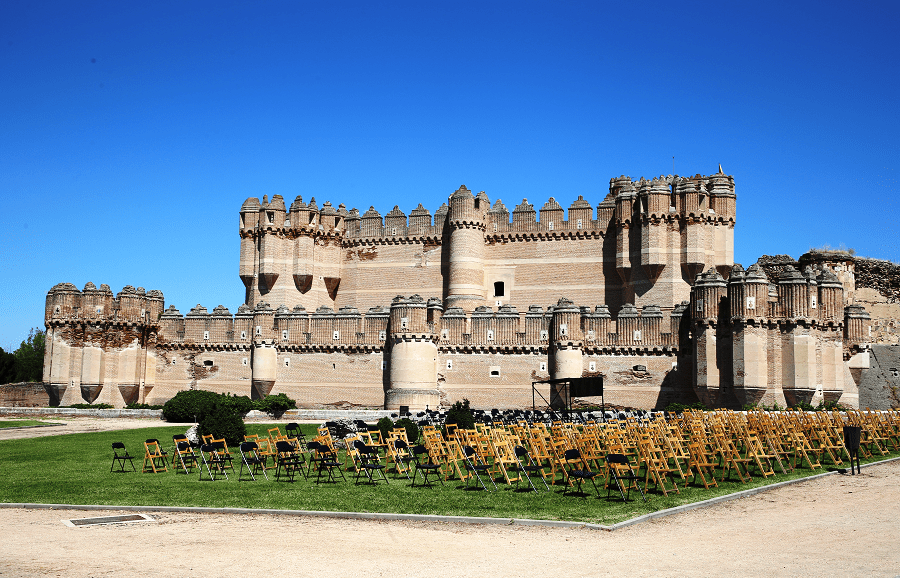The Castle of Coca, located in the central region of Spain within the municipality of Coca, stands as a remarkable example of Spanish Mudejar brickwork. Built during the 15th century, this fortress is widely regarded as one of the finest representations of the architectural fusion between Moorish Muslim design and the Gothic style that defined much of Spain’s medieval period. Its construction embodies a unique blend of cultural influences, reflecting the historical complexities of Spain during the late Middle Ages.

Unlike many medieval castles constructed from stone, the Castle of Coca is primarily built with bricks, a characteristic feature of Mudejar architecture. This style, which flourished in Spain between the 12th and 16th centuries, was shaped by the coexistence of Christian and Muslim traditions following the Reconquista. The extensive use of brick allowed for intricate detailing and geometric patterns, hallmarks of Moorish craftsmanship. At the same time, the Gothic influences contributed to the imposing presence of the castle, giving it a distinctly fortified appearance.
The history of the Castle of Coca is deeply tied to Spain’s turbulent past. Commissioned by the powerful Fonseca family, a lineage closely connected to the Castilian monarchy, the castle was not only a defensive stronghold but also a symbol of power and prestige. Don Alonso de Fonseca, an influential figure in the court of King John II of Castile, was instrumental in its construction. Under his direction, the castle was designed to serve both as a fortress and a luxurious residence, a dual purpose that was not uncommon among the nobility of the period.
Strategically positioned near the Voltoya and Eresma rivers, the castle’s location was chosen for its natural defensive advantages. The surrounding landscape, with deep ravines and water barriers, added another layer of protection. Unlike castles built on elevated hills, Coca’s castle relies on a deep moat and thick walls to deter potential invaders. The moat, once filled with water, enhanced the fortress’s ability to withstand sieges, a critical feature during an era of frequent conflicts and power struggles.
One of the most striking aspects of the Castle of Coca is its exterior design. The intricate brickwork, arranged in elaborate geometric patterns, showcases the Moorish influence in Spanish construction techniques. Decorative elements, such as interlocking arches and ornamental friezes, are reminiscent of Islamic architecture, which had a lasting impact on Spain’s artistic heritage. Despite these Moorish elements, the structure retains its Gothic character, evident in the tall towers and robust defensive walls designed to withstand attacks.
Inside the castle, visitors can explore a variety of well-preserved chambers that reveal the grandeur of its original design. The main courtyard, or patio de armas, serves as the central gathering space, surrounded by arched galleries that lead to different sections of the castle. The grand hall, once used for important gatherings and ceremonies, is adorned with detailed plasterwork, another hallmark of Mudejar artistry. The ceilings, with their elaborate wooden coffering, demonstrate the exquisite craftsmanship that defined Spain’s architectural achievements during the 15th century.
One of the most fascinating parts of the castle is its underground network of tunnels and passageways. These hidden corridors, some of which extend beneath the surrounding landscape, were used for both defensive and logistical purposes. They allowed for discreet movement during times of siege and served as escape routes when needed. This feature highlights the strategic planning involved in the castle’s construction, ensuring its inhabitants could sustain prolonged attacks if necessary.
Despite its formidable defenses, the Castle of Coca eventually fell into disrepair over the centuries. By the 18th century, it was largely abandoned, its walls gradually succumbing to the effects of time. However, efforts to restore the fortress began in the 20th century, recognizing its historical and architectural significance. Today, the castle stands as one of Spain’s most well-preserved Mudejar-style fortresses, attracting historians, architects, and tourists eager to witness its unique beauty.
The Castle of Coca is now managed by Spain’s Ministry of Culture and serves as both a historical site and an educational center. It houses a forestry school, allowing students to study environmental sciences within the walls of a medieval stronghold. This unusual combination of historical preservation and modern education makes Coca a distinctive landmark among Spain’s many castles. Its continued use ensures that the legacy of its construction and historical importance is not forgotten.

Visitors to the castle can explore its interior through guided tours, gaining insight into the life of Spanish nobility during the 15th century. The experience of walking through its halls, touching the centuries-old brickwork, and standing on the towers that once guarded the region offers a profound connection to Spain’s past. The view from the highest points of the castle provides a stunning panorama of the surrounding countryside, further emphasizing its strategic placement in the Castilian landscape.
Beyond its architectural and historical significance, the Castle of Coca plays an essential role in Spain’s cultural heritage. It stands as a testament to the artistic and technical achievements of the Mudejar period, a time when Muslim, Christian, and Jewish influences merged to create some of the most remarkable structures in Spain. The castle’s enduring presence reminds visitors of the rich, diverse history that shaped the Iberian Peninsula, a history marked by conflict, collaboration, and artistic innovation.
As one of the few remaining examples of a fully Mudejar-style fortress, Coca continues to captivate scholars and travelers alike. Its preservation allows future generations to appreciate the intricate craftsmanship that defined medieval Spain. The castle also serves as a reminder of the political and social complexities of the time, illustrating how power, art, and culture intersected in ways that still influence Spanish identity today.
For those interested in medieval history, architecture, or Spanish heritage, a visit to the Castle of Coca is an unforgettable experience. It offers a glimpse into a world where fortified walls and artistic beauty coexisted, where noble families built grand residences that doubled as defensive structures, and where centuries of cultural exchange left an indelible mark on Spain’s landscape. The Castle of Coca remains one of the most extraordinary examples of Spain’s medieval past, a structure that continues to inspire awe and admiration more than five centuries after its construction.
In summary, the Castle of Coca is more than just a historical relic; it is a symbol of Spain’s architectural brilliance and a monument to the country’s rich, multifaceted past. It stands as a living reminder of the artistic ingenuity and strategic foresight of its creators, ensuring that its legacy endures for generations to come.





